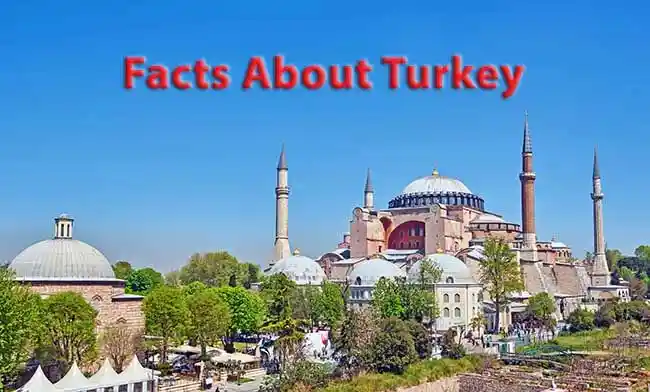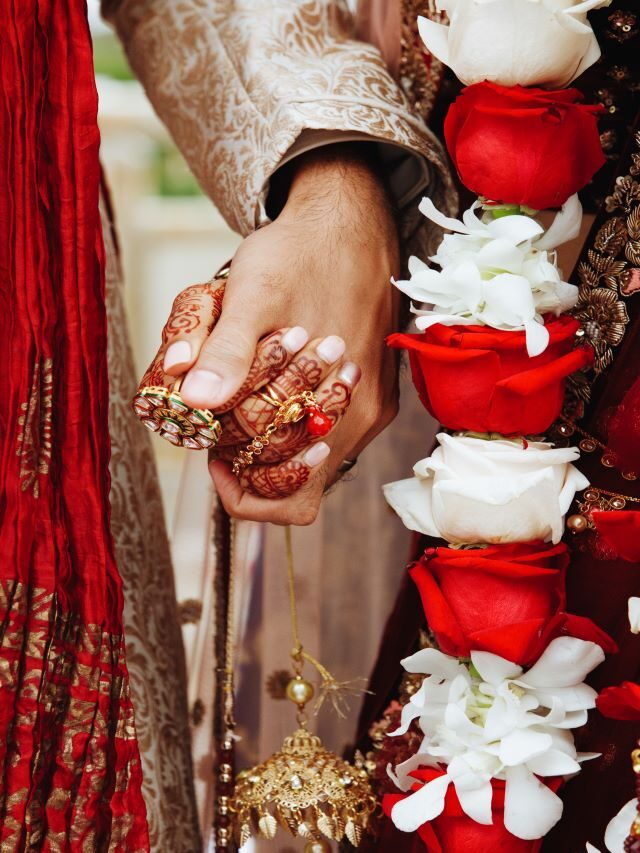Amazing Facts about Turkey
You probably did not know the real name of Turkey, you may have been confused about which city is the capital, and you may have believed that tulips originated in the Netherlands.
Evidently, you were possibly in a mistake. Turkey, commonly known as Türkiye, is a country with a unique geographical location, spanning both Asia and Europe.
It has always been both a barrier and a connection between the two continents.
In addition to its beaches and lively marketplaces, Turkey has a rich past replete with religious and literary luminaries, a civil war, and a variety of languages.
Discover the coolest things to do in Turkey after reading these interesting facts you probably did not know.

Facts about Turkey Country
- OFFICIAL NAME: Republic of Turkey
- FORM OF GOVERNMENT: Parliamentary Democracy
- CAPITAL: Ankara
- AREA: 783,562 Square Kilometers (302,535 Square Miles)
- POPULATION: 81,257,239
- OFFICIAL LANGUAGE: Turkish
- MONEY: Turkish Lira
1. The first Christian church was established in Antioch, Turkey.
It is believed that Jesus' disciple Simon Peter built the Grotto of Saint.
Peter outside of Antioch (now known as Antakya). This makes it the world's oldest Christian worship site.
Today, visitors can still observe remains of the church's ancient décor.
To find more churches in Turkey, travel to the southeast of the country.
Diyarbakir and its environs are lined with beautiful religious structures, including St. Mary Church.
2. Historians believe agriculture originated in Turkey.
Historians say that farming began in Turkey about 11,000 years ago.
There is clear evidence that ancient people grew barley and wheat in the south-central part of Turkey.
3. Santa Claus was born in Patara, Turkey

Ruins of the ancient Lycian city in Patara © Fotopanorama360/Shutterstock
Saint Nicholas, often known as Santa Claus, is the historical figure who inspired Santa Claus.
Born in Patara circa 300 A.D., he later became the bishop of nearby Demre on the Mediterranean coast of Turkey.
Many believe he performed many miracles during his lifetime, such as rescuing sailors from sinking ships.
St. Nicholas became one of the patron saints of sailors as well as the inspiration for Santa Claus through stories of his generosity.
The name Santa Claus is derived from the Dutch 'Sinter Klaas,' which is a shortened form of Sint Nikolaas.
Even though Santa Claus originated in Turkey, the primarily Muslim country does not traditionally celebrate Christmas.
Ramadan is the most significant of Turkey's many religious celebrations.
Saint Nicholas' Church in Demre is modest, but contains well-preserved frescoes and is renowned as the burial site of Saint Nicholas.
He was the bishop of an ancient church. It is an important example of Byzantine architecture.
Currently, the majority of visitors are Eastern Orthodox Christians for whom Saint Nicholas, as the patron saint of children, is an important religious figure.
It is not uncommon for Russians to shed tears while visiting his tomb.
In close proximity are the Lycian rock tombs of Myra, carved into a rock face that now overlooks agricultural fields, and an antique theatre.
Both Myra and Saint Nicholas' Church are reachable via Antalya, irali, Kaş, and Kalkan, all of which are situated on the southern coast on either side of Demre.
4. The Republic of Turkey - the official name of the country
The territory that is now the Republic of Turkey was a part of the Ottoman Empire until the empire's collapse following the First World War.
The Turkish War of Independence followed, and Mustafa Kemal Atatürk became the first President of the Republic in 1923.
If you wish to discover more about the interesting history of Turkey, you should visit the Topkapi Palace in Istanbul.
It is a significant icon of the Ottoman Empire. The palace complex is accessible every day except Tuesday.
5. Istanbul connects both Europe and Asia.

One of the most interesting facts about Istanbul, the largest city in Turkey, is that it straddles Europe and Asia.
It is the only metropolis on earth that spans two continents.
This is due to the city's location on the Bosphorus, a gorgeous strait between Europe and Asia.
Moreover, the Golden Horn inlet divides the European side of Istanbul in half.
Istanbul is very beautiful. In fact, it is on our list of Europe's most beautiful cities.
Each area in Istanbul has its own distinct atmosphere and personality.
The most famous sites are located in the Old City, Sultanahmet, and its environs.
Karakoy and Nisantasi are other districts worth exploring.
In addition, there are the ruined neighborhoods of Fener and Balat, with their cobblestone lanes overlooking the Golden Horn.
6. Leonardo da Vinci initially designed a bridge across the Golden Horn.
Leonardo da Vinci submitted drawings for a bridge across the Golden Horn, the inlet of the Bosphorus that divides Istanbul (then known as Constantinople), in 1503.
Although Turkish President Recep Tayyip Erdogan claimed several years ago that a volunteer project was underway to fully realize Da Vinci's plans, the bridge was never constructed.
7. People and Culture of Turkey
The ethnic diversity of the Turkish people is a reflection of the multiple groups that conquered Turkey throughout centuries.
The majority of the population resides in urban areas, and students who wish to attend high school are required to move to a city.
Sunni Muslims predominate with 80% and 20% are Kurdish.
Youngsters who reside on the European side of Istanbul may travel by boat to Asia to visit their grandparents.
Turks are family-oriented and hospitable people.
They invite guests to their houses and provide them with food and drink before they leave.
One of their favorite dishes is grilled lamb kebabs. The staples of their diet are lamb, eggplant, and yogurt.
Turkish delight, or lokum, is a sweet candy containing rose petals that is available in a variety of tastes and colors.
Over two million Turks are currently working as foreign laborers in Germany, where they have established their own communities.
In Turkey, soccer is the most popular sport. Three prominent teams are situated in Istanbul.
The Turks excel at weightlifting and Turkish wrestling, a type of wrestling.
8. Aesop, Herodotus, and Saint Paul the Apostle were born in Turkey.
Several sources believe that the renowned Greek storyteller Aesop was born in Thrace, beside the Black Sea (now Nesebar).
Herodotus, the Greek historian, was born in what is now the coastal city of Bodrum.
Fascinating cultural aspects of Turkey
9. The Netherland (Holland) should thank Turkey for Tulipomania

The first tulips were grown in the Ottoman Empire.
In the 1600s, the Dutch ambassador to the court of Turkey's Süleyman the Magnificent brought a bunch of tulip bulbs back to Amsterdam.
This started the country's love of tulips.
In April, Istanbul hosts a week-long event honoring the national flower.
There are concerts, art exhibitions, and competitions at various locations throughout the city.
10. Turkey is credited for 75% of the world's exports of hazelnuts.

The majority of the world's hazelnuts are grown in the Mediterranean region, specifically in Turkey, Greece, Italy, and Spain.
Italy is the second-largest producer, contributing over 20% of the global supply.
Nuts can be included in a variety of Turkish desserts, such as baklava.
11. About 30 languages are spoken in Turkey.
The number of languages spoken in Turkey is one of its most amazing features.
Turkey's official language is Turkish, but more than thirty minority languages are also spoken there.
These languages include Kurmanji (Northern Kurdish), Mesopotamian Arabic, and Zazaki.
12. The sixth most popular tourist destination in the world
Turley is one of the most famous international tourist destinations.
This country has everything: magnificent beaches, scenic landscapes, historic sites, and delicious food.
Before the epidemic, nearly 45 million foreign tourists visited Turkey in 2019.
13. "Muvaffakiyetsizleştiricileştiriveremeyebileceklerimizdenmişsinizcesine" is the Turkish word with the longest length.
It has 70 letters and translates as "As if you are from those whom we may not be able to quickly transform into unsuccessful ones."
Yet the word was created specifically for a novel and is not often used.
14. 40 is a lucky number

In various religions, 40 is a lucky number, and for the Turkish people, 40 is a lucky number.
Traditionally, if you repeat something forty times, it will come true.
This belief originates from the fact that the prophet Muhammad was 40 when he received the Quran and that Jesus spent 40 days in the desert.
15. It is illegal to wear a Fez in Turkey.
The iconic red felt hat with a black tassel derives its name from Fez, Morocco.
This is the origin of the red dye used to color the hat. In the 1920s, Mustafa Kemal Atatürk banned the fez because it was viewed as a symbol of the Ottoman Empire.
Although the legislation has not been removed, it is doubtful that you will be arrested for wearing one!
16. The Turkish breakfast is significant
Food is an integral aspect of Turkish culture, and Turkey is a culinary paradise.
I recommend beginning your day in Turkey with the most essential meal of the day: breakfast.
The typical Turkish breakfast is usually served until 1 p.m.
The traditional Turkish breakfast consists of various cheeses, olives, marmalade, butter, bread, and eggs.
17. Turkey's capital is Ankara, not Istanbul.
Many people think Istanbul is Turkey's capital, however, Ankara is. Istanbul is simply Turkey's largest city.
Throughout Turkey's history, Ankara has been an important trade centre, and it has expanded to become a vital economic, art, and cultural powerhouse.
18. Turkish people throw water after saying their goodbyes.
When you say your goodbyes to your Turkish friends, they may hurl a bucket of water at you.
This suggests they want you to have a happy return.
Throwing water after someone leaves, particularly on a trip, is very customary not only in Turkey but also in Iran.
This custom dates back to a time when travel was rare.
19. Istanbul was once known as "Byzantium."
The name "Byzantium" derives from Greek and relates to the city's founder, Byzas.
It was renamed "Constantinople" in 324, and Istanbul was added in 1930.
20. The "Evil Eye" is the souvenir that people buy the most.

The "Nazar bonus," or "evil eye," is a stone made of glass, iron, and copper that has been melted together.
It is a 3000-year-old tradition that people wear to keep evil away. People think that the blue color of the stone can protect against bad energy.
21. The Oldest should be the first to go.
Turkish people have a high regard for the elders.
When they enter the room, the oldest is always the first to enter.
On rare situations, younger people will kiss the right hand of an older and lift their hand to their brow.
22. The Santa Claus story started in Turkey.

Nicholas was born in Patara to wealthy parents.
He was a Christian saint and the Greek bishop of Myra.
When his parents died, he got a lot of money from them, which he gave to people who were poor and in need.
The story goes that he would drop bundles of gold coins down people's chimneys and give children fruit.
His good works spread throughout Europe, and locals began to weave them into their myths and legends.
23. Turkey has the world's greatest tea consumption.
Tea is an important part of Turkish culture, and each person in Turkey drinks more tea than anyone else in the world.
Every Turk consumes 3 to 4 cups of tea each day.
This number rises throughout the winter, when tea houses are popular places to gather.
Although Turkey is known for its coffee, 96% of the population consumes at least one cup of tea every day.
Turkish tea is traditionally served in small glasses shaped like tulips and is known for its strong flavour.
On your trip, make sure to sample all of their unique tea flavors.
24. Turkey has a young population.
Turkey has the most young people in the EU.
Turkey's average age is around 31, while only 9% of the population is over 60.
25. The city of Istanbul (ancient Constantinople) was built on seven hills.
Istanbul, like Rome, was built on seven hills.
This was not a coincidence; the Byzantine Empire built the city in this manner to claim itself as the new Rome.
All seven hills are historically significant and are surrounded by beautiful mosques and palaces.
26. The term "turquoise" is derived from Turkey.
Turquoise is a Turkish stone.
The beautiful gemstone arrived in Europe from the East via Turkey and is one of history's earliest gemstones.
Ottoman warriors first used them as amulets.
27. Early Christians flourished underground in Cappadocia during the Roman and Byzantine periods.
Cappadocia was used as a hiding spot by Christian communities who buried themselves in underground towns carved from soft rock before Christianity became an accepted religion in the region.
They are still open to the public, as are several pieces of evidence of early churches carved into the rocks and fairy chimneys, many of which have well-preserved religious murals painted on the walls.
The Göreme Open Air Museum includes excellent examples of these chapels, and you can see the murals inside the fairy chimneys.
There are panoramic viewpoints nearby where you may observe some of the region's most spectacular structures.
28. Oil wrestling is considered to be the national sport of Turkey.
Oil wrestling, which is also known as grease wrestling, is one of the oldest sports still played in Turkey.
Before participating in oil wrestling, competitors first coat themselves in the slippery oil and then face off against one another.
29. There are 82,693 mosques located in the country of Turkey.
While Muslims make up around 99% of the population of Turkey, the country is home to a few of the world's most magnificent mosques.
The Sultanahmet Mosque in Istanbul also referred to as the "Blue Mosque," is widely regarded as being among the most magnificent mosques in all of Turkey.
30. The Tünel funicular railway in Turkey is the oldest subterranean railway in Continental Europe that is still in service.
Karakoy and Beyolu are both served by the Tünel, which first opened its doors in 1875.
It is the second-oldest subway system in the world, after only the London Underground, which first welcomed passengers in 1863.
Between the riverfront neighborhood of Beyolu (which was once referred to as Galata) and the affluent hilltop neighborhood of Karakoy (which was formerly known as Pera).
It is where many of the city's banks and embassies were located, the tunnel is 600 meters uphill.
31. According to the myth, Noah's ark landed on Mount Ararat.
There is a widespread and persistent myth that the biblical ark landed on the mountain of Ararat.
The mountain is stunning to look at and is home to an amazing variety of native plant and animal life.
When you go to the country, you shouldn't miss out on seeing this attraction because it's one of the best in the whole place.
32. The length of Turkey's coastline along the Black Sea is 1,175 kilometers,
The length of Turkey's coastline is the same as the distance that can be driven between London and Venice.
You should go to Trabzon, which is located on the eastern coast of the Black Sea.
Its medieval landmarks and beautiful landscapes make it a standout destination in the surrounding area.
While on the western side, you can visit Sinop, which is recognized as having one of the most stunning stretches of shoreline along the Black Sea.
33. The Grand Bazaar in Istanbul has 64 streets and more than 4,000 shops.

Mosaic Ottoman lamps hanging at the Grand Bazaar in Istanbul © Berke/Shutterstock
The Grand Bazaar is one of the oldest and largest markets in the world.
Every day, up to 400,000 people come to shop there. People often say that it is one of the oldest malls in the world.
If you want to learn how to bargain and not get lost, you might want to go with a local guide.
Monday through Saturday, from 9 am to 7 pm, the market is open.
If you like to buy local goods and souvenirs when you travel, you might be interested to know that the Grand Bazaar in Istanbul.
In Turkish is called Kapali Carsi, is the oldest covered market in the world. It dates back to 1455.
Over the years, it has grown into a 61-street maze that takes up 333,000 square feet and has more than 3,000 stores.
You can find some amazing local products here, like Turkish rugs, beautiful lamps, tea, and Turkish delight.
Let yourself get lost in this beautiful maze for a while and have fun shopping.
Mosaic Ottoman lamps hang from the ceiling at the Grand Bazaar in Istanbul.
34. Even though camels are often seen at vacation spots, they are not native to the country.
Turkey doesn't have a desert, so there aren't any camels that live there.
Even so, camel trains used to travel across the country to reach trading posts in Africa and Asia.
In the Aegean area of Turkey, camel wrestling is also a popular sport.



